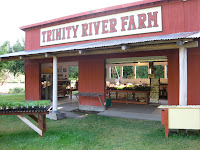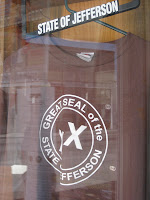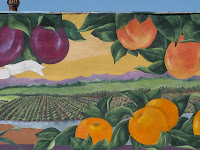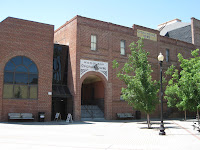The best weekday to visit Fallbrook is Thursday, when both museums in town are open without appointments being necessary.
Mission Road and Main Avenue are now part of Historic U.S. Highway 395 that refers to the original narrow two-lane road that once connected Temecula, Rainbow, Fallbrook, Escondido and points south. The San Diego County Department of Public Works began installing the historic designation highway signs in 2008.
We found tree-shaded on-street parking on Main Avenue near Alvarado Street and strolled first to the Fallbrook Area Visitor Bureau, 111 W. Alvarado Street. Armed with maps and brochures, we first headed to the Fallbrook Gem and Mineral Society Museum, 123 W. Alvarado Street. The principal emphasis of their gem and mineral collection is the tourmaline mines in San Diego County. They also have an impressive mineral collection illuminated by ultra-violet light in a curtained-off back room.
The area located along Main Avenue north of Alvarado Street to Mission Road has a strong Latino flavor. It was fun strolling through the El Toro Market, a large, authentic Mexican-style bodega, located at 337 N. Main Avenue. We had never seen so many fresh tortillas in one place! It reminded us of bodegas we saw in Oaxaca with their extensive selection of mole sauce.
Fallbrook is remaking itself as an art center. The Fallbrook Art Center, 103 S. Main Avenue, is the headquarters for the Fallbrook Center for the Arts Group. The exhibit space is in a former 1961 Rexall Drug store, which was converted to the art gallery/museum in 1994. The Café des Artistes occupies the original Rexall lunch counter with one of the few authentic soda fountains remaining in San Diego County.

 We decided to have lunch at the Café, which features Mediterranean-style cooking. We both had a panini/acorn squash soup combination plate ($9.50), followed by a split of a sinful flourless chocolate cake ($4.50). Delicious! Note the mural of famous artistes by Brett Stokes where Doug is sitting.
We decided to have lunch at the Café, which features Mediterranean-style cooking. We both had a panini/acorn squash soup combination plate ($9.50), followed by a split of a sinful flourless chocolate cake ($4.50). Delicious! Note the mural of famous artistes by Brett Stokes where Doug is sitting.Although the Art Center was not officially open to visitors that day (it was being set up for a juried art show), the management allowed us to take a quick look at the exhibit anyway.
 The Fallbrook Center for the Arts Group also sponsors a variety of outdoor public art, consisting of murals and bronze sculptures. The mural is that of a sepia photo depicting historic Downtown Fallbrook in the 1920s.
The Fallbrook Center for the Arts Group also sponsors a variety of outdoor public art, consisting of murals and bronze sculptures. The mural is that of a sepia photo depicting historic Downtown Fallbrook in the 1920s. Village Square Park, 102 S. Main Avenue is a pleasant public park and outdoor performance space amidst quaint shops and restaurants. It is also the location for Fallbrook Farmer's Markets held Fridays and Sundays, along with the Art Center's parking lot on Sundays.
Village Square Park, 102 S. Main Avenue is a pleasant public park and outdoor performance space amidst quaint shops and restaurants. It is also the location for Fallbrook Farmer's Markets held Fridays and Sundays, along with the Art Center's parking lot on Sundays. We had some time to kill before our next attraction opened to visitors, so we drove to the 1887 First Methodist Episcopal Church, 318 W. Fig Street. It sits on a prominent site west of the historic downtown. The First Christian Church of Fallbrook now occupies this beautifully kept Italianate-Victorian church.
We had some time to kill before our next attraction opened to visitors, so we drove to the 1887 First Methodist Episcopal Church, 318 W. Fig Street. It sits on a prominent site west of the historic downtown. The First Christian Church of Fallbrook now occupies this beautifully kept Italianate-Victorian church.We drove through conventional suburban sprawl (malls and multiple-family housing) lining S13 (South Mission Road) to reach the Fallbrook Historic Society Museum, 260 Rocky Ridge Road. The entrance to the Museum is off of Hill Street, just south of the west end of Rocky Ridge Road. The Museum comprises two buildings open to visitors: the two-level Main Museum and the Pittenger Country House.
The centerpiece of the main exhibit space is the working model train lined with 12 miniature reproductions of some of Fallbrook’s most prominent Victorian-era buildings, many of which do not exist anymore. The model steam engine is unusual in that it reflects a design current in the 1880s.
The California Southern Railroad (later incorporated into the Atchison, Topeka and Santa Fe Railroad during a reorganization) once connected Oceanside with Temecula, with the right-of-way following the Santa Margarita River to a rail depot and stage stop in Fallbrook, then continuing through Temecula Canyon. Washouts from heavy rains in 1884, 1891 and 1916 created major problems for rail operations, which were eventually forced to shut down. (See “The Fallbrook Line” by Richard V. Dodge for a summary of the travails the railroad operators faced.
The museum had some unusual items unique to the Fallbrook area. For example, there was a floor-standing clock constructed entirely of avocado wood.
The smaller Ford Room occupies the lower level of the main building, Its exhibits include two antique Ford automobiles, a Model T and a Model A; a barbed wire collection; and a display detailing the history of U.S Highway 395.
The Reverend William Pittenger Country House, built in 1890, lies just south of the museum and is also open to the public. Reverend Pittinger was the first pastor to lead the First Methodist Episcopal Church on Fig Street. Although his primary residence was the 1892 Parsonage (still located across from the church at 135 Mission Road and now occupied by the Fallbrook Healthcare Foundation), he built the farmhouse as a retreat. The various rooms are furnished in different period styles ranging from the 1880s to the 1920s. The docent even played a turn-of-the-20th Century Victrola record player that required a crank to operate!
The Historical Society recently constructed a replica of a “California-style” barn that will be used for displaying farm implements and meeting space. This structure is located to the east of the main museum, accessed by a separate entrance off Rocky Crest Road.

 On the way home, we decided to visit one of the many nurseries in the Fallbrook area. One of the more attractive is the Myrtle Creek Nursery, located at 2940 Reche (pronounced “richee”) Road a few miles east of town in the bucolic Live Oak Park area. Note the water wheel and garden setting of the place. The 1940s farm house now serves as a store, offering produce, preserves and gourmet gifts as well as plant related items.
On the way home, we decided to visit one of the many nurseries in the Fallbrook area. One of the more attractive is the Myrtle Creek Nursery, located at 2940 Reche (pronounced “richee”) Road a few miles east of town in the bucolic Live Oak Park area. Note the water wheel and garden setting of the place. The 1940s farm house now serves as a store, offering produce, preserves and gourmet gifts as well as plant related items.We completed our loop by taking Gird Road south to SR 76, back to I-15, then home. This was a pleasant day, indeed!




























































































































